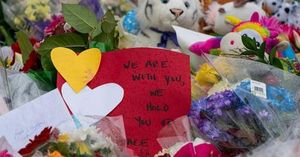A tragic incident occurred in Myanmar that has brought attention to the dangers associated with social media-driven behavior among youths. On July 22, 2024, 14-year-old Moe Sa Nay, a rising TikTok star, slipped and fell to her death while attempting to take selfies at the top of Sinywa Waterfall in the town of Paung, Mon State. The young influencer had garnered a following of 150,000 fans, with many drawn to her lively personality showcased in her online posts.
Moe was reportedly posing for photographs with a friend when she lost her footing on the slick rocks at the waterfall's edge. As she fell, she was swept away by the swift current of water, quickly becoming trapped between two large boulders. Attempts by rescue workers to save her were unsuccessful on the same day as her fall, leading to a grim wait until the next morning before her body could be retrieved. Local authorities faced significant challenges navigating the turbulent waters to reach her.
According to reports from rescue workers, the friend who was with Moe also slipped but managed to escape with minor injuries. Mon Zaw, a rescuer involved in the operation, recounted the harrowing details: "The one who slipped reached the bottom but died after getting stuck between the rocks. She died because she couldn’t get out. They tried to rescue her but couldn’t pull her out. Then the aid organizations and officials came."
The loss of Moe Sa Nay highlights a growing concern about the perils related to selfie-taking, especially at unsafe locations. Recent studies have indicated that selfies can pose a substantial public health risk. Data compiled indicated that between January 2008 and July 2021, a staggering 379 individuals died while attempting to capture selfies around the world. Falls from heights, like cliffs or waterfalls, were identified as the predominant cause of these tragic incidents.
Moe’s fatal accident is not an isolated incident. Only months before, another tourist fell over 170 feet to her death while posing at a cliffside vantage point. The incident is part of a worrying trend where individuals disregard safety precautions in pursuit of the perfect photo for social media. Oftentimes, this reckless behavior involves crossing barriers and disregarding clearly marked warnings. It raises questions about the responsibility of social media platforms to promote safety among their users.
Experts suggest that preventative measures could significantly decrease the likelihood of selfie-related accidents. Proposed strategies include the establishment of 'no selfie' zones, the use of physical barriers at dangerous locations, and the implementation of informative signage directing users toward safer practices. Despite calls for such initiatives, little progress has been made in terms of concrete policies.
Despite the overflowing grief among her followers, many on TikTok have capitalized on the story, expressing sorrow for the loss while simultaneously scrutinizing the influence of social media on youth behavior. They lament a culture that pressures individuals to prioritize online visibility over personal safety. Comments from Moe’s followers poured in, some saying, "It’s so heartbreaking to hear about this loss. Life is precious; be careful." Others vented their frustration, stating that influencers often prioritize likes and views at the expense of their safety, a sentiment that resonates deeply in a climate of increasing mental health concerns tied to social media influence.
The phenomenon of selfie-related accidents has raised important discussions around the psychology of social media fame and its repercussions. The pursuit of the perfect image often leads to dangerous situations, suggesting an alarming shift in cultural values where aesthetics can overshadow safety and common sense.
Moe’s tragic fate also underscores the responsibility of social media platforms to take action. Organizations like TikTok must consider the safety implications of their platforms and implement proactive measures to promote safe practices for their users. This includes not only user education but employing algorithms that discourage dangerous behaviors.
As the investigations into Moe's untimely death continue, the community and her followers mourn a vibrant young life cut short. Thousands of social media users are left grappling with the harsh reality that sometimes the quest for social media recognition can come at a devastating cost. This incident stands as a sobering reminder of the need for mindful content creation—one that prioritizes safety over sensationalism.
Looking outward, it seems increasingly necessary to engage in robust discussions about social media’s role in shaping risky behavior among youth. As self-made influencers are born and die on platforms like TikTok, the question remains: how can society find a balance between celebrating creative expression and ensuring the safety of its most vulnerable members?
More than just a loss of life, Moe Sa Nay's passing acts as a catalyst for broader societal reflection on the amalgamation of youth, social media, and the tragedies that can arise when the two intersect too dangerously. It beckons a change in both mindset and policy, creating space for this contemporary crisis to be addressed and for future generations to engage with social media in a more conscious and secure manner.



